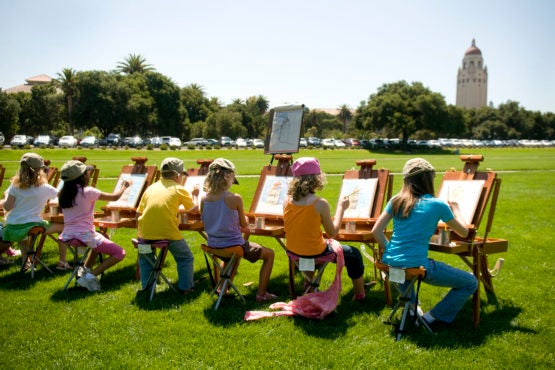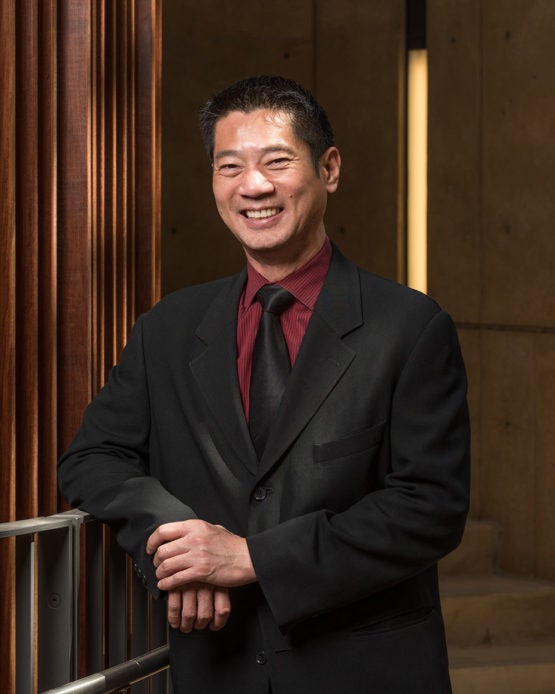Stanford transitions from classes to camps and conferences
When Stanford’s undergraduate students go home for the summer, some 20,000 people bring the campus back to life at camps and conferences that are aligned with the university’s teaching, learning and research mission.
The transition has begun. Just a couple of weeks ago, the campus was populated by bike-riding college students toting backpacks and heading to class. Today, the campus is instead filled with T-shirt-wearing campers, age 6 to 18, and adult conference attendees from around the world. Phillip Gin, executive director of Stanford Conferences, talks about summer at Stanford.
How many campers and conferences are you expecting this summer?
We are hosting about 275 camps and conferences through August that will bring well over 20,000 guests to Stanford. The weekend after Commencement, for instance, more than 4,000 guests arrived and checked into residences that housed students just a week earlier. All of the summer camps and conferences held on campus are sponsored by a Stanford department and verified to be supportive of the university’s mission of teaching, research or public service.

Campers like these young artists flock to the Stanford campus every year for summer activities. (Image credit: L.A. Cicero)
What are the biggest internal and external programs?
More than 3,000 students will be coming to campus to attend Stanford’s Pre-Collegiate Studies programs. For many years, iD Tech has been the largest external program. It is holding 24 sessions of five different programs throughout the course of the summer. More than 2,000 youths will be residing on campus to attend these programs.
Is anything new this year?
One new program that stands out is the Aspen Presidential Fellowship for Community College Excellence, which is sponsored by the Graduate School of Education. The program will host 55 guests plus 15 mentors with a focus on preparing the future leaders of the community college systems. Over the next decade, more than 80 percent of community college presidents are projected to retire, which necessitates investment in new leaders. This is a great example of an organization aligned with the university’s vision and values.
Are there any other camps or conferences you want to note as being especially aligned to the mission of the university?
Listen to Me! was created by the Baker Institute for Children with Hearing Loss and is sponsored by the School of Medicine. It is an intensive, one-week training program for children, families and professionals to learn how to foster listening and spoken language development with cochlear implants. Funding for those who attend is based on a sliding scale through the Baker Institute.
The founder, Jenny McCall, started the institute because her first child, Caroline, was not able to talk. It took about a year to get a correct diagnosis and the help Caroline needed. Caroline was initially behind in her speech, listening and learning skills. Fast forward to today: Caroline closed the gap. In fact, she just received her MBA from Stanford this June!
The children who attend the program are inspiring. I met a little girl, Elena, who can speak two languages – English and Cantonese – and is learning Mandarin. Witnessing how Listen To Me! impacts the lives of these children and their families makes all the work we do worth it.
How are summer conferences and camps affected by construction in the residences?
Every summer, Residential & Dining Enterprises (R&DE) tries to find the right balance of summer programs residing in the residences and renovation and construction projects that preserve the useful lives of these buildings. There are always programs that we would love to host, but don’t have the space to accommodate. Stanford Conferences and R&DE’s Maintenance and Capital Projects team work closely to ensure that Stanford’s residences are well-cared-for while providing summer homes for as many summer camps and conferences as possible.
A recent priority has been increased attention to the protection of minors. How are those efforts going?
Each year since Stanford’s adoption of the Protection of Minors Policy (Admin Guide 1.8.1), responsiveness among the Stanford community on policy requirements improves as university officials become more aware of the importance of youth safety efforts. All programs that host minors now register with us. We help make sure they are compliant with university requirements.
How do summer camps and conferences benefit the university?
In my conversations with university department sponsors of visiting camps and conferences, I have heard a great deal about the work they do in concert with external organizations toward academic advancement.
“Many of our summer programs are designed for first generation and/or underprivileged students.”
—Phillip Gin
Executive Director, Stanford Conferences
The School of Law, for example, sponsors Envision, which introduces high school students to the law while serving as a recruitment tool. The administrators we work with tell us that the program encourages high school students’ passion for the law and is a good pipeline to law school. It allows Stanford to reach a broad range of students interested in the law, particularly from underrepresented groups.
In fact, many of our summer programs are designed for first generation and/or underprivileged students. The experience they have while attending summer camps and conferences at Stanford often has a significant impact on their lives. They get exposed to academic disciplines and fields that we hope influence their future studies, careers and interests. We hope that every student attending summer programs at Stanford takes away newly developed skills, learned knowledge and greater confidence.
Is there also a financial benefit for the university?
Our summer programs provide revenue that offsets increases in the cost of room and board for Stanford students. In addition, the 20,000 guests create job opportunities, including employment of about 75 Stanford students by R&DE each summer, employment of additional students by other university departments supporting conference operations, and employment of Stanford students by external programs as counselors.
Additionally, Summer Conferences helps keep staff throughout the university consistently employed for the entire year; such positions would likely be limited to nine-month employment contracts without summer conferences.
Additionally, several external programs offer scholarships for Stanford faculty and staff so that their children may attend their programs at no cost. Each summer, iD Tech provides 15 such scholarships to Stanford, with priority given to those employees at lower household income brackets. The Stanford National Forensic Institute, which offers sessions in public speaking, provided 10 scholarships this year and Digital Media Academy provided 200 scholarships.

